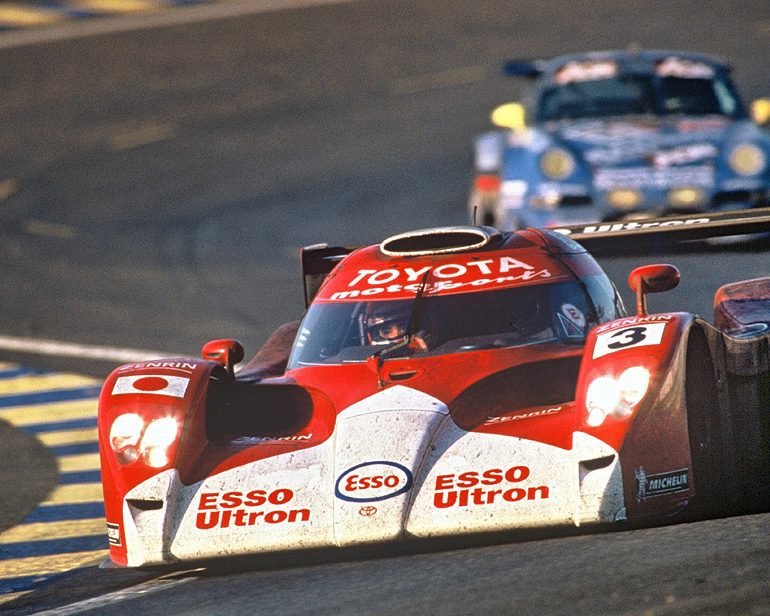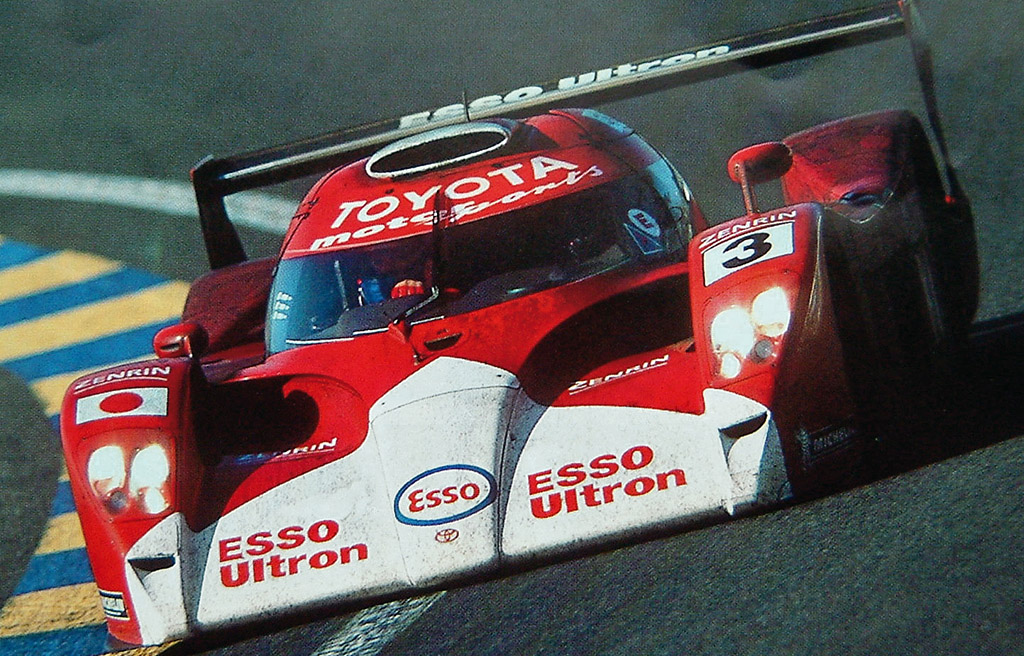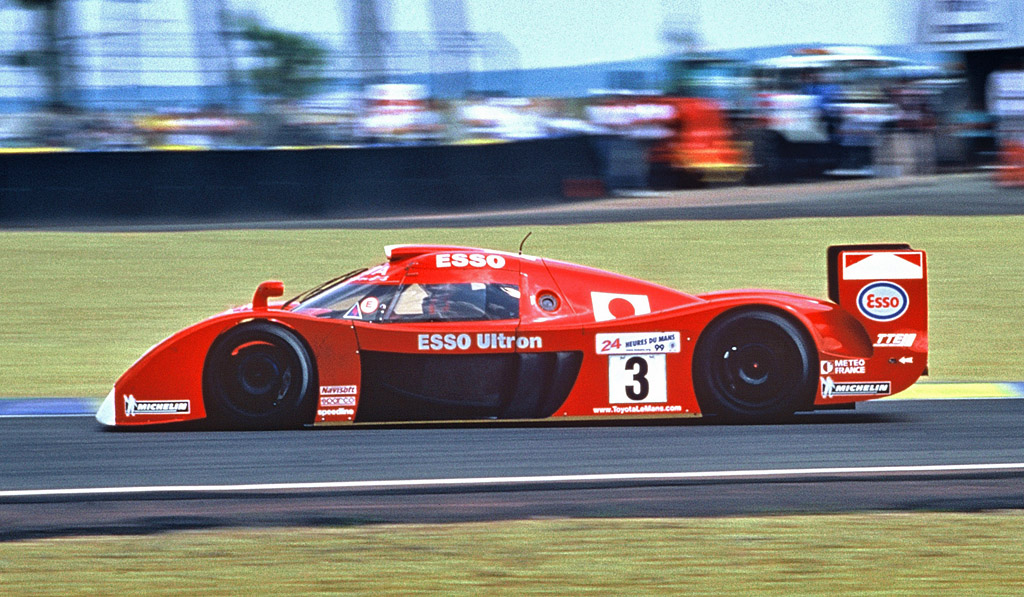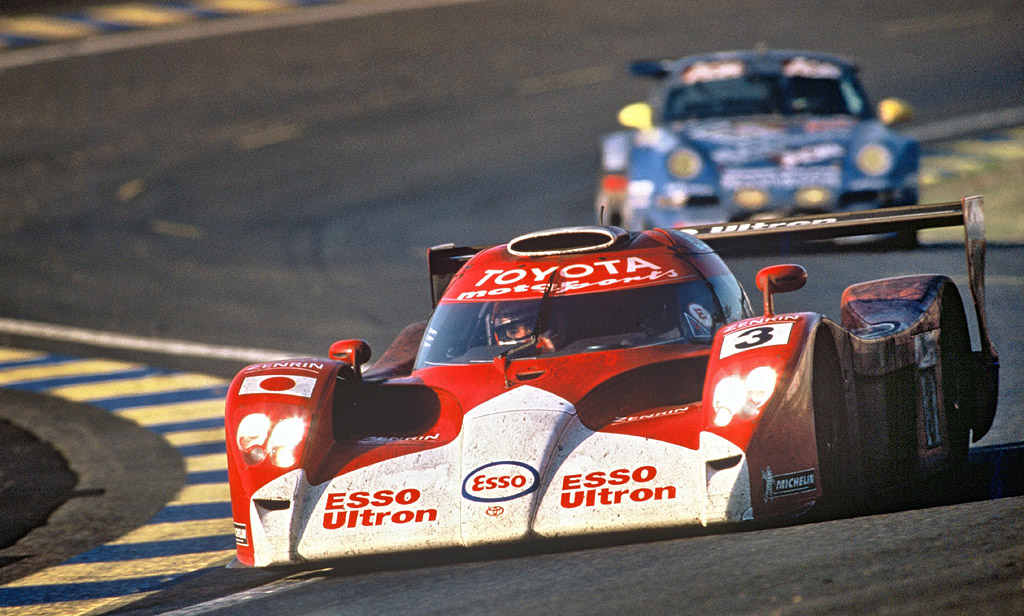1998→1999 Toyota GT-One
The Toyota TS020, better-known in Europe as the Toyota GT-One, is a pure-bred Le Mans car, created specifically to contest the world’s most famous 24-hour race with no compromise in terms of design or engineering.
The GT-One was built at Toyota Motorsport’s headquarters in Cologne, the work of a team assembled specially for the task by Andre de Cortanze. De Cortanze completed the chassis concept in January 1997 and within two months work was well in hand on the general design and details of the car’s front, rear and fuel tank. By May the doors and the rear and side structures were finished and the job was completed by September.
In its day, the design project was one of the most advanced in motor sport. No drawing boards were used, the work was accomplished entirely on CAD systems.
The first chassis was delivered in October 1997, the sleek shape of the bodywork having been refined using a wind tunnel in Italy. De Cortanze’s design was characterised by minimal air vents in the body.
The engine had its heritage in the twin-turbo V8 which powered Toyota’s Group C cars in the late 1980s. The TTE (Toyota Team Europe) engine division, led by Norbert Kreyer, completely revised the original design, reducing the height and weight, improving fuel economy, boosting power and changing the rev range.
The first GT-One chassis ran in December 1997, less than a year from the start of the project. Initial test and development was undertaken by Martin Brundle, but later all nine drivers from the Toyota Le Mans squad were given significant time at the wheel.
In accordance with the FIA rules of the day, the GT-One had also to be developed as a legal road car. In fact the differences between the race and road versions were small: in road-going mode, the rear wing was set lower and the suspension ride height was raised. A smaller fuel tank was fitted and the addition of catalytic converters ensured the vehicle complied with emissions regulations.
The car made its first competition appearance in the 1998 Le Mans race, qualifying in second. The team of Thierry Boutsen, Emmanuel Collard and Eric Hélary held second place in the race until the final hour, when the Toyota was forced into retirement through transmission failure. Team-mates Ukyo Katayama, Toshio Suzuki (who pilots the car once again at the Goodwood Festival of Speed) and Keiichi Tsuchiya took the chequered flag in ninth position.
Toyota returned to Le Mans the following year and swept all competition aside in qualifying to claim first, second and third places on the grid in qualifying. However, in the race the number 1 and 2 cars of Brundle/Collard/Sospiri and Boutsen/Kellners/McNish were sidelined by separate accidents. The third car of Katayama/Suzuki/Tsuchiya made rapid progress in the second half of the race and posted a new lap record of 3m 35.032s on its way to a second place finish.
Story by Toyota
In Detail
| tags | gt1, lmgtp, ts020 |
| submitted by | Richard Owen |
| type | Racing Car |
| production years | 1998 – 1999 |
| released at | 1998 24 Hours of Le Mans |
| built at | Cologne, Germany |
| body stylist | Dallara |
| coachbuilder | Toyota Team Europe |
| production | 7 |
| predeccesor | 1993 Toyota TS10 Le Mans |
| succeccesor | 2012 Toyota TS030 HYBRID |
| engine | R36V V8 |
| position | Mid, Longitudinal |
| aspiration | Twin Turbochargers |
| displacement | 3600 cc / 219.7 in³ |
| bore | 86.0 mm / 3.39 in |
| stroke | 77.0 mm / 3.03 in |
| compression | 9.0:1 |
| power | 447.4 kw / 600.0 bhp |
| specific output | 166.67 bhp per litre |
| bhp/weight | 666.67 bhp per tonne |
| torque | 650.0 nm / 479.4 ft lbs |
| body / frame | Carbon Fibre Composite |
| front brakes | Carbon Fibre Discs |
| rear brakes | Carbon Fibre Discs |
| curb weight | 900 kg / 1984 lbs |
| wheelbase | 2800 mm / 110.2 in |
| front track | 1600 mm / 62.9 in |
| rear track | 1644 mm / 64.7 in |
| length | 4840 mm / 190.6 in |
| width | 2000 mm / 78.7 in |
| height | 1125 mm / 44.3 in |
| transmission | 6-Speed Sequential |







